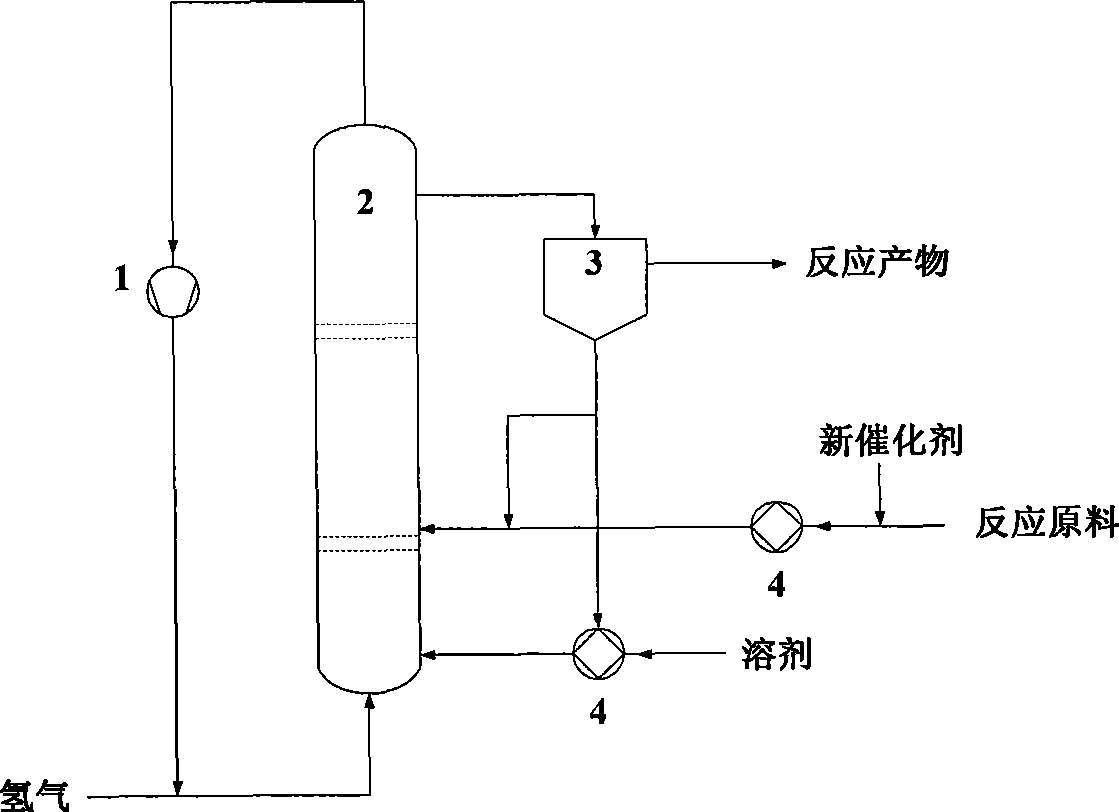Method for preparing m-phenylene dimethylamine
A technology of m-xylylenediamine and isophthalonitrile, which is applied in the field of preparation of m-xylylenediamine, can solve the problems of easy wear and tear of catalyst, loss of catalyst catalytic activity, increase of fatigue strength of reactor, etc. Generation of by-products, long catalyst life, and high hydrogen utilization
- Summary
- Abstract
- Description
- Claims
- Application Information
AI Technical Summary
Problems solved by technology
Method used
Image
Examples
Embodiment 1
[0027] Embodiment 1 adopts the method described in the present invention to prepare m-xylylenediamine by the continuous hydrogenation of isophthalonitrile, and its technological process is as follows figure 1 shown.
[0028] Hydrogen enters from the bottom of the regeneration zone of the reaction / regeneration coupling reactor 2, and the reaction raw materials (isophthalonitrile and solvent) and fresh catalyst enter from the middle of the reaction / regeneration coupling reactor 2 (bottom of the reaction zone), and the isophthalonitrile Continuous hydrogenation reaction of formonitrile, the reaction material realizes gas-liquid separation in the head space of coupling reactor 2. The tail gas discharged from the top of the reactor 2, that is, the unreacted hydrogen is recycled after being pressurized by the compressor 1; the liquid-solid mixture extracted from the top of the reactor 2 enters the liquid-solid separator 3 for liquid-solid separation, so that the solid catalyst and ...
Embodiment 2~6
[0032] Examples 2-6 According to the process method of Example 1, m-xylylenediamine was continuously prepared. The difference lies in the catalyst used in the hydrogenation reaction, the reaction temperature and pressure, and the regeneration temperature and pressure. When a Raney nickel catalyst is used, the Raney nickel is a commercially available Raney nickel catalyst with a nickel content of 87.5% by weight.
[0033] The reaction results are shown in Table 1.
[0034] Table 1 The reaction results of the continuous hydrogenation of isophthalonitrile to m-xylylenediamine
[0035]
Embodiment 7
[0037] Embodiment 7 adopts the method described in the present invention to prepare m-xylylenediamine by the continuous hydrogenation of isophthalonitrile, and its technological process is as follows figure 2 shown.
[0038] Hydrogen enters from the bottom of the regeneration zone of the reaction / regeneration coupling reactor 2, and the reaction raw materials (isophthalonitrile and solvent) and fresh catalyst enter from the middle of the reaction / regeneration coupling reactor 2 (bottom of the reaction zone), and the isophthalonitrile Continuous hydrogenation reaction of formonitrile, the reaction material realizes gas-liquid separation in the head space of reactor 2. The tail gas discharged from the top of the reactor 2, that is, the unreacted hydrogen is recycled after being pressurized by the compressor 1; the liquid-solid mixture extracted from the top of the reactor 2 enters the liquid-solid separator 3 for liquid-solid separation, so that the solid catalyst and The reac...
PUM
 Login to View More
Login to View More Abstract
Description
Claims
Application Information
 Login to View More
Login to View More - R&D
- Intellectual Property
- Life Sciences
- Materials
- Tech Scout
- Unparalleled Data Quality
- Higher Quality Content
- 60% Fewer Hallucinations
Browse by: Latest US Patents, China's latest patents, Technical Efficacy Thesaurus, Application Domain, Technology Topic, Popular Technical Reports.
© 2025 PatSnap. All rights reserved.Legal|Privacy policy|Modern Slavery Act Transparency Statement|Sitemap|About US| Contact US: help@patsnap.com



